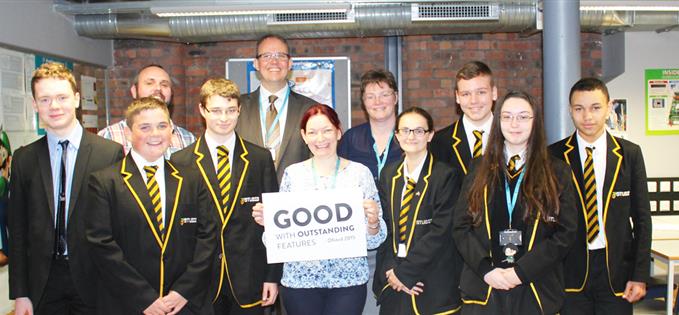Primary schools in parts of the Liverpool city region are every bit as excellent as those in the London Borough of Kensington and Chelsea.
But when they make the leap into “big school”, children in Knowsley, Liverpool and St Helens, are entering some of the worst performing classrooms in the country.
Sir Michael Wilshaw, Chief Inspector of Schools, said in his annual report for Ofsted, the country’s education watchdog, that England is “a nation divided at the age of 11” describing his findings as ‘deeply troubling’.
His report cites 13 local authority areas in the country - including Liverpool, Knowsley and St Helens – where almost 400,000 secondary school children attend schools that are not good enough: fewer than 60 percent are rated as good or outstanding, compared to a national average of 74 percent.
Sir Michael said there is much to celebrate about England’s schools, with more children than ever currently in good and outstanding schools. Primary schools in particular are excelling, he reported, with 85 percent now rated good or outstanding, up from 82 percent last year.
But he says the gap between primary and secondary schools has not narrowed.
The proportion of good and outstanding secondary schools has increased in the last year from 71 percent to today’s average score of 74 percent, with the greatest improvement seen in the south.
 Sir Michael Wilshaw, Chief Inspector of Schools
Sir Michael Wilshaw, Chief Inspector of SchoolsIn the North and Midlands just 68 percent of secondary schools are good or better, with all of Merseyside below average.
In Liverpool just 57 percent of students attend schools rated as good or outstanding, in St Helens it is 56 percent, while Sefton (71 percent), Wirral (71 percent) and Halton (70 percent), are closer, but still lower than the national average.
The poorer ratings for secondary schools is in sharp contrast to primary schools. Knowsley and Halton both score 91 percent (the same as schools in Kensington and Chelsea), St Helens earns a score of 90 percent, Wirral 87 percent, Sefton matches the national average of 85 percent and Liverpool comes in as bottom of the class with 84 percent.
Sir Michael said: “We are witnessing an educational division of the country after age 11, with secondary schools performing well overall in the South but struggling to improve in the North and Midlands.
“The facts are stark. Compared to secondary school children in the South, those in the North and Midlands on average make less progress in English and maths, perform worse at GCSE and attain fewer top grades at A-level,” he said.
“If left unaddressed the consequences will be profound. Our society, our future prosperity and development rely on the better education of our children. As things stand, too many secondary schools in the North and Midlands are failing to equip young people with the skills and knowledge they and the country need.
“I fear that unless we resolve these divisions our country’s educational progress will be seriously impeded and we will not be able to compete as well with our international competitors.”
Sir Michael said the key to raising standards in under-performing regions and cities was “collective action and political will”.
“If Liverpool, Manchester, Leeds, Sheffield, and Newcastle are to be engine rooms of a Northern powerhouse, one of their priorities must be working with the towns on their borders to raise attainment and close skills gaps across a wider area,” he said.
His report also found achievements of pupils from low-income backgrounds remain a weakness in Britain’s education system.
He also highlights recruitment as a serious problem, particularly for schools in challenging areas, which are facing severe difficulties securing the good teachers and leaders they need.
Sir Michael concluded: “All of our evidence shows that it is good leadership that makes the biggest difference to school standards. Yet in many areas of the country there is a shortage of good leaders.
“The most troubling weakness in our education system remains the performance of children from low income backgrounds. They suffer disproportionately when leadership is weak, oversight is poor and recruitment of good teachers is difficult.
“Sadly, the ‘long tail of underachievement’ that prevents too many of our poorest children realising their potential shows few signs of being eradicated.”
How schools stack up in Liverpool
 In the clear: The technology based Studio School in the former NOVAS building
In the clear: The technology based Studio School in the former NOVAS buildingThe Studio School Liverpool - Good
41 Greenland Street, Liverpool, Merseyside, L1 0BS
Childwall Sports & Science Academy Requires Improvement
Queens Drive, Liverpool, Liverpool, Liverpool, Merseyside, L15 6XZ
King's Leadership Academy, Liverpool Special Measures
Dingle Vale, Liverpool, Merseyside, L8 9SJ
St Margaret's Church of England Academy - Good
Aigburth Road, Liverpool, Merseyside, L17 6AB
West Derby School - Requires Improvement
364 West Derby Rd, Liverpool, Merseyside, L13 7HQ
St Francis Xavier's College - Good
High Lee, Beaconsfield Road, Liverpool, Merseyside, L25 6EG
The Blue Coat School - Outstanding
Church Road, Wavertree, Liverpool, Merseyside, L15 9EE
Bellerive FCJ Catholic College - Good
Windermere Terrace, Sefton Park, Liverpool, Merseyside, L8 3SB
St Edward's College - Outstanding
Sandfield Park, Liverpool, Merseyside, L12 1LF
The De La Salle Academy - Good
Carr Lane East, Croxteth, Liverpool, Merseyside, L11 4SG
Enterprise South Liverpool Academy - Special Measures
51 Horrocks Avenue, Garston, Liverpool, Merseyside, L19 5NY
North Liverpool Academy - Requires improvement
120 Heyworth Street, Liverpool, Merseyside, L5 0SQ
St Hilda's Church of England High School - Good
Croxteth Drive, Sefton Park, Liverpool, Merseyside, L17 3AL
Cardinal Heenan Catholic High School - Requires Improvement
Honeysgreen Lane, Liverpool, Merseyside, L12 9HZ
St Julie's Catholic High School - Good
Speke Road, Woolton, Liverpool, Merseyside, L25 7TN
Notre Dame Catholic College - Good
180 Great Homer Street, Liverpool, Merseyside, L5 5AF
King David High School - Outstanding
Childwall Road, Liverpool, Merseyside, L15 6UZ
Gateacre School - Requires Improvement
Hedgefield Road, Gateacre, Liverpool, Merseyside, L25 2RW
Calderstones School - Requires Improvement
Harthill Road, Liverpool, Merseyside, L18 3HS
Broadgreen International School, A Technology College - Requires Improvement
Queens Drive, Liverpool, Merseyside, L13 5UQ
Alsop High School Technology & Applied Learning Specialist College - Requires Improvement
Queen's Drive, Liverpool, Merseyside, L4 6SH
URN: 104693
Fazakerley High School - Good
Sherwoods Lane, Fazakerley, Liverpool, Merseyside, L10 1LB
Holly Lodge Girls' College - Requires Improvement
140 Mill Lane, West Derby, Liverpool, Merseyside, L12 7LE
The Academy of St Francis of Assisi - Good
Gardners Drive, Kensington, Liverpool, Merseyside, L6 7UR
Broughton Hall Catholic High School - Good
Yew Tree Lane, West Derby, Liverpool, Merseyside, L12 9HJ
St John Bosco Arts College1 Outstanding
Storrington Avenue, Croxteth, Merseyside, L11 9DQ
The Belvedere Academy1 Outstanding
17 Belvidere Road, Princes Park, Liverpool, Merseyside, L8 3TF
Archbishop Blanch School1 Good
Earle Road, Liverpool, Merseyside, L7 6HQ
Archbishop Beck Catholic Sports College1 Requires Improvement














